Amazon FBA Storage Fees Explained - Updated for 2024
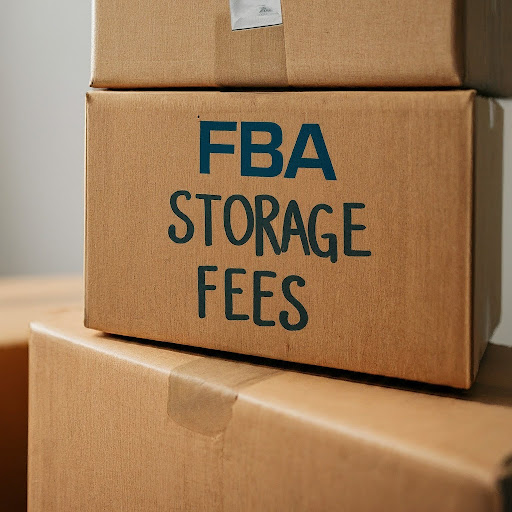
If you're using Fulfillment by Amazon (FBA) to streamline your business operations, it's essential to understand the various fees involved. FBA fees include charges for storing, handling, and shipping your products to customers, and they can quickly add up if not managed effectively. This blog provides a detailed breakdown of the key Amazon FBA fees in 2024, how to calculate them, and strategies to minimize these costs.
Key Types of Amazon FBA Fees
Amazon FBA fees fall into several categories, each affecting your profit margins in different ways. Here's a detailed overview of the main types of fees:
1. Fulfillment Fees
Fulfillment fees are the primary charge for sellers using FBA. They are based on the size and weight of the product and cover the cost of picking, packing, shipping, and customer service. Amazon updates these fees annually to reflect changes in operational costs. To see the exact fulfillment fees here’s all the information below ⬇️
Fees for Non-Apparel (Small-Standard Only)👇
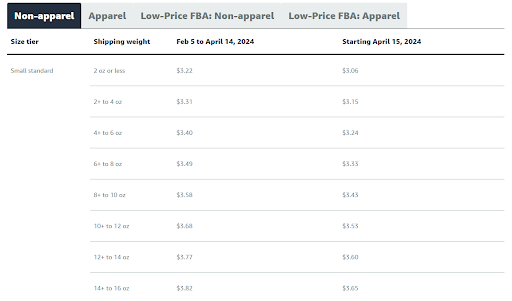
Fees for Apparel (Small-Standard Only)👇
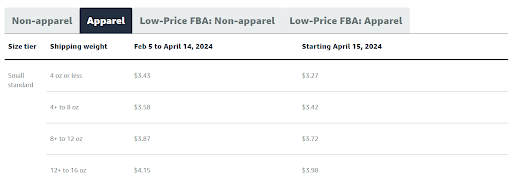
2. Monthly Inventory Storage Fees
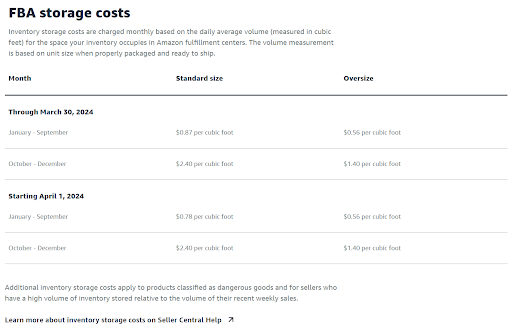
Amazon charges storage fees for keeping your inventory in their fulfillment centers. The fees depend on the volume of your products (measured in cubic feet) and the time of year. Storage fees are significantly higher during the fourth quarter (October to December) due to increased demand for warehouse space.
-
Non-Peak Season (January to September):
Standard Products: $0.87 per cubic foot
Oversize Products: $0.56 per cubic foot -
Peak Season (October to December):
Standard Products: $2.40 per cubic foot
Oversize Products: $1.20 per cubic foot
To minimize these fees, manage your inventory levels effectively and avoid overstocking during peak season.
3. Aged Inventory Surcharge
Amazon imposes an aged inventory surcharge on items stored in fulfillment centers for more than 365 days. This fee is charged in addition to the regular monthly storage fees.
- Aged Inventory Fee: $6.90 per cubic foot or $0.15 per unit, whichever is greater.
If you have slow-moving inventory, consider running promotions or using Amazon’s Removal Order Service to avoid long-term storage fees.
4. Removal Order Fees
If you need to remove or dispose of unsellable or excess inventory, Amazon offers removal services. You can have Amazon either return the items to you or dispose of them.
-
Standard Size Product: $0.97 per unit
-
Oversize Product: $1.45 per unit
This fee can be significant for high-volume sellers, so it's important to regularly audit your inventory and remove unsellable items before they incur long-term storage fees.
5. Returns Processing Fees
Amazon charges a returns processing fee when they offer free return shipping for products in certain categories. This fee is particularly relevant to sellers in categories such as apparel and shoes.
- Returns Processing Fee: Based on the size and weight of the product, this fee can range from $2 to $5 for most categories.
To minimize return-related expenses, ensure your product listings are accurate, and your products meet customer expectations.
Additional FBA Fees to Be Aware Of
Apart from the major fees listed above, there are other smaller but important fees that can impact your overall costs.
6. Unplanned Service Fees
If your inventory arrives at an Amazon fulfillment center without proper preparation or labeling, Amazon will handle these tasks for you—at a cost.
-
Labeling Fee: $0.55 per item
-
Bubble Wrapping Fee: $1.00 per item
To avoid these fees, ensure your products meet Amazon’s packaging and labeling requirements before shipping them to a fulfillment center.
7. FBA Inventory Storage Overage Fees
If you exceed your allocated storage capacity at Amazon’s fulfillment centers, you’ll be charged an overage fee.
- Overage Fee: Applied per cubic foot if your inventory exceeds your storage limit.
To avoid this fee, monitor your storage usage in Seller Central and ensure you stay within your allocated capacity limits.
8. Reservation Fees
If you reserve additional storage capacity, Amazon will charge you a reservation fee. This fee is charged if you request additional storage space but fail to generate sales during the period.
- Reservation Fee: Based on cubic feet of storage requested.
This fee applies to sellers who anticipate needing more storage during peak times but are unable to meet the sales volume necessary to offset the reserved space.
How to Reduce Amazon FBA Fees
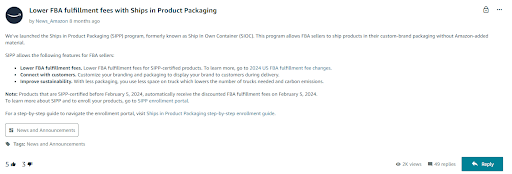
Now that you know the types of FBA fees and how they work, here are some actionable strategies to help reduce them:
-
Enroll in the Ships in Product Packaging (SIPP) Program: SIPP allows you to ship products in custom-brand packaging without Amazon adding extra materials, which lowers fulfillment fees for SIPP-certified products. Additionally, it enhances branding opportunities and contributes to more sustainable shipping practices. Products certified before February 5, 2024, will automatically receive discounted fees.
-
Optimize Product Dimensions and Packaging: Keep your products small and lightweight to fall into lower size tiers and reduce fulfillment fees.
-
Use Inventory Management Tools: Track your inventory levels to avoid long-term storage fees. Regularly audit your stock and remove slow-moving products to keep your storage fees low.
-
Bundle Products: By bundling related products, you can reduce the number of individual units that need to be picked and packed, which may lower fulfillment fees.
-
Avoid Peak Season Overstocking: Since storage fees are higher during the Q4 peak season, aim to send only enough inventory to cover sales during this period. Use sales history data to forecast demand and avoid overstocking.
Conclusion
Amazon FBA fees can significantly impact your bottom line, but with careful planning and strategic inventory management, you can reduce these costs and improve your profitability. Regularly reviewing your FBA fees, optimizing your product dimensions, and efficiently managing your inventory are key to long-term success on Amazon.
If you need personalized guidance or help fine-tuning your strategies, Superfuel AI can assist. Our AI-powered assistant analyzes 36+ key Amazon metrics to identify and address the root causes of sales fluctuations, helping you optimize your storefront and boost sales. Reach out to us at [email protected].
--
Ben Mathew, Amazon Expert
Ben Mathew is a co-founder at Superfuel, a sales assistant for Amazon sellers. In the past, Ben and his team of e-commerce specialists and software engineers have launched 40+ new brands on Amazon, taking them from zero to bestsellers. In his free time, he is either learning from other top sellers or encouraging his 3 daughters in their love for reading. He is reachable at ben [at] superfuel.io.
FAQs
-
**What are Amazon FBA fulfillment fees?
**Amazon FBA fulfillment fees cover the costs of picking, packing, shipping, and handling your products. These fees are based on the size and weight of your products. -
**How can I avoid long-term storage fees?
**To avoid long-term storage fees, regularly audit your inventory and use removal orders to eliminate slow-moving products before they hit the 365-day mark. -
**What is the Fee Preview Tool?
**The Fee Preview Tool in Seller Central helps sellers estimate their fulfillment fees based on product size, weight, and category. -
**Are FBA fees higher during peak season?
**Yes, Amazon increases storage fees during the peak season (October to December) due to higher demand for warehouse space. -
**What happens if I exceed my storage limit?
**If your inventory exceeds your storage limit, Amazon will charge an overage fee based on the volume of excess inventory.